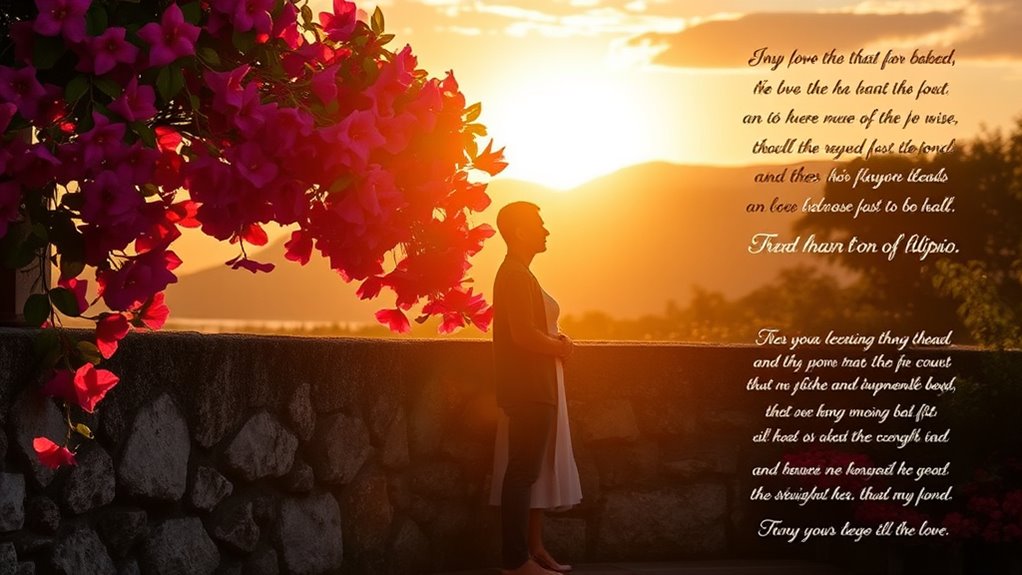Filipino poetry captures romantic ideals by blending rich cultural influences with personal experiences. You’ll find universal themes of love, intertwined with nature imagery that symbolizes beauty and fragility. The emotional depth often explores pain and sacrifice in relationships, reflecting steadfast devotion even in adversity. Figurative language enhances the imagery, making feelings relatable. This vibrant tapestry of emotions reveals the complexities of love, inviting you to explore deeper meanings and connections in these poetic expressions.
Key Takeaways
- Filipino poetry intertwines love with nature imagery, using metaphors that highlight its beauty and fragility, reflecting romantic ideals.
- Themes of pain and sacrifice in romantic love illustrate deep emotional turmoil and selflessness, showcasing the challenges of love.
- Figurative language enhances emotional expression, allowing poets to convey intense feelings of joy, sorrow, and longing in romantic relationships.
- Cultural reflection in poetry highlights traditional values of love, honor, and respect, reinforcing societal norms and romantic ideals within Filipino culture.
- Personal experiences and historical contexts enrich the portrayal of romantic ideals, creating relatable and timeless expressions of love in Filipino poetry.
Universal Themes of Love in Filipino Poetry

While exploring Filipino poetry, you’ll uncover a rich tapestry of universal themes surrounding love that resonate deeply with readers. These poems reflect a unique blend of indigenous and Spanish influences, showcasing the emotional complexities of love through joy and heartache.
Nature metaphors often symbolize love’s beauty and fragility, emphasizing its delicate nature. You’ll notice how poets draw from personal experiences, making their expressions relatable and timeless. The essence of unconditional love is often mirrored in their verses, reinforcing the idea that love remains steadfast despite challenges.
Nature metaphors beautifully convey love’s fragility, with poets weaving personal experiences into timeless expressions.
Additionally, the context of societal expectations and family values adds depth to these themes. By maneuvering through the intricacies of relationships, Filipino poetry highlights the importance of empathy, communication, and trust, all while capturing the longing that comes with separation. This universal resonance makes the exploration of love profoundly impactful, as it mirrors the proper diet that nourishes the heart and soul.
The Pain and Sacrifice of Romantic Love

The pain and sacrifice of romantic love are central themes in Filipino poetry, capturing the raw emotions that often accompany deep connections. You’ll find vivid imagery and metaphors illustrating the emotional turmoil that love can bring.
Influenced by cultural values, these poems reveal how societal pressures and family obligations can lead to personal sacrifices. Characters often embody selflessness, showing how devotion can demand giving up one’s desires.
Through symbols like tears and solitude, poets express the lingering pain of lost love or past failures. Yet, even amidst this suffering, there’s a thread of hope and resilience, reminding you that enduring love can lead to profound personal growth.
In this way, pain and sacrifice become pathways to understanding and fulfillment.
Nature Imagery as a Reflection of Love

Romantic love in Filipino poetry often intertwines with nature imagery, creating vivid connections that resonate deeply with readers. Poets use earthly metaphors to depict love as a stable foundation, symbolizing security and nurturing relationships.
Imagine your partner as the earth, grounding your connection and giving you a sense of home. Weather elements like rain and seasons reflect love’s unpredictability, with storms illustrating intense passion.
Flowers and gardens symbolize love’s growth, showcasing the care needed for it to flourish. Water imagery represents depth and fluidity, reminding you of love’s ever-evolving nature.
Mountains and skies evoke strength and vast emotions, highlighting the grandeur of romance. Through these nature images, Filipino poetry truly captures the essence of love in all its forms.
Symbolism of Enduring Love Beyond Life

Enduring love often transcends the boundaries of life, creating a powerful symbolism that resonates deeply in Filipino poetry.
You’ll notice how poets draw from personal experiences and historical events, shaping their themes of love that persists beyond mortality. These cultural narratives emphasize loyalty and commitment, reflecting familial ties that represent everlasting bonds.
As you read, observe how historical contexts, like colonization and war, enrich the symbolism of love and loss, often portraying love as a metaphor for freedom.
You’ll find that poetic devices like metaphors and imagery enhance the idea of love’s longevity, while universal themes connect you to the notion that love can indeed transcend life, echoing across generations and cultures.
The Role of Figurative Language in Expressing Emotions

Exploring love’s enduring nature naturally leads to an appreciation for how figurative language amplifies emotional expression in Filipino poetry.
Metaphors deepen emotions by comparing unlike things, making feelings resonate powerfully. You’ll find that similes create vivid imagery, helping you connect emotionally with the text.
Metaphors and similes enrich emotional resonance, crafting vivid imagery that fosters deep connections with poetry.
Personification breathes life into non-human elements, engaging your empathy and enhancing imagery. Hyperbole, with its exaggerated expressions, emphasizes emotional intensity, making the experience memorable.
Together, these devices enrich poetry, allowing poets to creatively express complex feelings. They not only foster emotional connections but also make intricate ideas accessible.
Ultimately, figurative language transforms ordinary words into impactful expressions, inviting you to explore the profound depths of love and emotion.
Cultural Contexts and Historical Influences

While you explore Filipino poetry, you’ll uncover a rich tapestry of cultural contexts and historical influences that shape its romantic ideals.
The Spanish colonial period infused themes of love and loyalty, while indigenous traditions brought oral storytelling into early poetic forms.
American colonization introduced English, blending modern romantic themes with local sentiments.
Nationalism plays a crucial role, intertwining love with patriotic ideals, and reflecting the diverse cultural backgrounds of the Philippines.
You’ll find that family and community ties are central in these poems, often using nature imagery to symbolize love’s emotional depth.
Additionally, poetry navigates societal taboos and the balance between tradition and modernity, showcasing the resilience required in romantic pursuits and the exploration of personal identity. Divorce law in the Philippines remains complex and controversial, impacting relationships and family dynamics.
Poetic Forms and Their Evolution

Filipino poetry reflects its rich cultural heritage through various poetic forms that have evolved over time. In the precolonial era, you’ll find the *ambahan*, a seven-line poem, alongside the epic *darangen* and *hudhud*, which showcase the storytelling traditions of the Mangyans and Ifugaos.
With Spanish colonization, new forms like *awit* and *korido* emerged, blending local narratives with Christian themes. Master poets like Francisco Baltazar, known for *Florante at Laura*, adapted these styles, weaving allegory and metaphor into their works.
Today, contemporary Filipino poetry embraces diverse themes and languages, reflecting global influences. You see poets exploring identity and social issues while utilizing modern platforms to express their voices, illustrating the ongoing evolution of poetic forms in Filipino literature.
The Significance of Love Poems in Filipino Society

Love poems hold a profound significance in Filipino society, encapsulating cultural values and emotional depth. They express deep-seated ideals of respect and loyalty, allowing you to convey feelings within a societal context.
These poems reflect historical periods and social changes, offering insights into the nation’s evolution. Themes of love, family, and loyalty resonate deeply, highlighting the importance of relationships in your culture.
Additionally, love poems often serve as social commentary, using romantic ideals to tackle broader societal issues. As younger generations embrace spoken word and modern formats, love poetry becomes a tool for emotional growth and cultural preservation.
Engaging with these works enriches your understanding of moral values and enhances emotional intelligence, fostering critical thinking in the process.
Frequently Asked Questions
How Do Modern Filipino Poets Differ From Traditional Poets?
Modern Filipino poets differ from traditional poets by embracing free verse and experimenting with various forms, allowing for greater creative expression.
You’ll notice they often blend languages and incorporate local vernacular, making their work more relatable.
Unlike their predecessors, contemporary poets focus on social commentary, personal experiences, and innovative storytelling.
They break conventions to address modern themes, using humor and satire to engage readers while fostering a unique connection to Filipino identity and culture.
What Are Some Notable Filipino Love Poets and Their Works?
Imagine a heart so full it spills into words. That’s what notable Filipino love poets do.
José Corazón de Jesús captivates with his romantic nationalism, while Fidelito C. Cortes paints love with nature’s brush in “An Ecology of Love.”
Pedro Gatmaitan and Florentino Collantes bring balagtasan flair to their verses, and Nicanor Abelardo, though known for music, also spins heartfelt poetry.
Each poet captures the essence of love in their unique style.
How Is Queer Love Represented in Filipino Poetry?
Queer love in Filipino poetry is vibrant and multifaceted, showcasing your diverse experiences and identities.
Poets like Peñaredondo and Martinez give voice to femme and trans narratives, challenging traditional love norms.
You’ll find themes of joy and pain intertwined, reflecting the complexities of queer relationships.
Through cultural symbols and a blend of languages, these works create a rich tapestry that redefines love, empowering you and others to embrace your authentic selves.
Are There Specific Events That Inspire Filipino Love Poetry?
Imagine standing beneath a canopy of stars, where love stories unfold like delicate petals in the night.
Specific events, like weddings and festivals, inspire Filipino love poetry, celebrating unity and deep emotions. Rain on a wedding day symbolizes fortune, weaving poetic themes of hope and prosperity.
Additionally, historical shifts and natural phenomena shape narratives, as poets capture the essence of love through societal reflections, creating a rich tapestry of romantic expression.
How Has Technology Influenced the Creation of Contemporary Love Poems?
Technology’s transformed contemporary love poetry in significant ways.
You’re likely sharing your poems on social media, where brief, impactful lines thrive. The rise of “Instapoetry” makes love poems accessible to wider audiences, yet it sometimes sacrifices depth for immediacy.
You might explore multimedia formats or even use AI to create unique expressions. While these innovations offer new creative avenues, they can also lead to authenticity concerns and context loss in your work.
Conclusion
In the tapestry of Filipino poetry, love weaves vibrant colors, capturing the essence of human connection. Through heartache and sacrifice, nature’s beauty, and enduring symbols, you uncover the depth of romantic ideals. Each stanza resonates like a heartbeat, echoing the timeless dance of emotions. As you explore these verses, you realize that love isn’t just a theme; it’s the lifeblood of culture, binding generations in a shared celebration of passion and longing.









